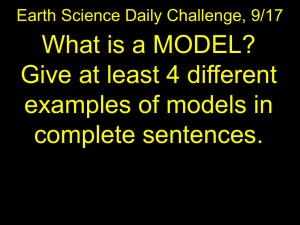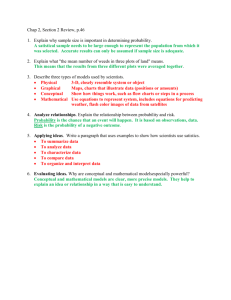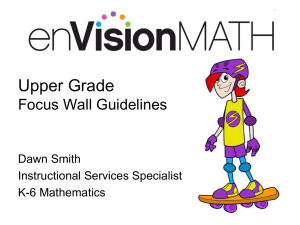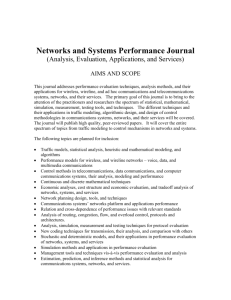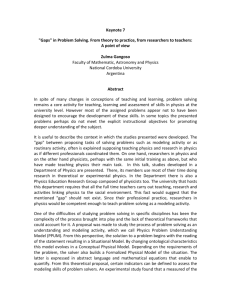Modeling Dr. Anis Koubâa CS433 Modeling and Simulation
advertisement
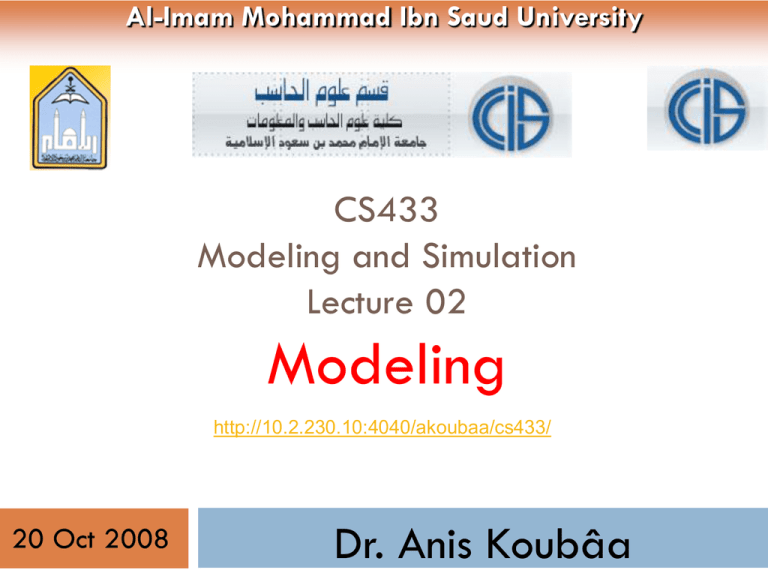
Al-Imam Mohammad Ibn Saud University CS433 Modeling and Simulation Lecture 02 Modeling http://10.2.230.10:4040/akoubaa/cs433/ 20 Oct 2008 Dr. Anis Koubâa 1 What is modelling? 2 A Model is a simplification of a real system Modelling is the process of representing a system with a specific tool to study its behaviour A model can be Analytic when a mathematical approach is feasible (e.g. Queuing Model) A simulation model used for complex systems 2 http://en.wikipedia.org/wiki/Model Model (as defined in Wikipedia) 3 A Model is a pattern, plan, representation (especially in miniature), or description designed to show the main object or workings of an object, system, or concept. Model may also refer to: Abstractions, concepts, and theories representations of objects human and animal behavior occupations history and culture lighting In geography … 3 Examples 4 In general, modelling is used for systems with some sort of uncertainty Waiting time in a restaurant/Aiport Time to go from home to the University Response time and Throughput of a web server The productivity of manufacturing systems Design of multi-processor machine Performance of MAC protocols (e.g. CSMA/CA) 4 Examples: Movement 5 Consider a system when a given object move This system can be modelled by the equation S= V * t Where S is the distance run through V is the speed of the object t is the time that has been observed. This is simplification of the real world Another model can take into account the direction of movement, or the three dimension coordinate … It is therefore to study the behaviour of the system based on a specific model 5 Examples: Model of a particle in a potential-field (Physics) source: http://en.wikipedia.org/wiki/Mathematical_model 6 In this model we consider a particle as being a point of mass m which describes a trajectory The trajectory is modeled by a function x : R → R3 given its coordinates in space as a function of time. The potential field is given by a function V:R3 → R and the trajectory is a solution of the differential equation Note this model assumes the particle is a point mass, which is certainly known to be false in many cases we use this model, for example, as a model of planetary motion. 6 Example: MAC Protocol (e.g. CSMA/CA) 7 Source: HE et al.: AN ACCURATE MARKOV MODEL FOR SLOTTED CSMA/CA ALGORITHM IN IEEE 802.15.4 NETWORKS, IEEE COMMUNICATIONS LETTERS, VOL. 12, NO. 6, JUNE 2008 A. Koubâa, M. Alves, E. Tovar A Comprehensive Simulation Study of Slotted CSMA/CA for IEEE 802.15.4 Wireless Sensor Networks In IEEE WFCS 2006, Torino (Italy), June 2006. Jelena Miˇsi´c∗ Vojislav B. Miˇsi´c Shairmina Shafi, Performance of IEEE 802.15.4 beacon enabled PAN with uplink transmissions in non-saturation mode – access delay for finite buffers, Proceedings of the First International Conference on Broadband Networks (BROADNETS’04) 7 Examples: Radio Propagation Model Source: http://en.wikipedia.org/wiki/Radio_propagation_model 8 A radio propagation model is an empirical mathematical formulation for the characterization of radio wave propagation as a function of frequency, distance and other conditions. Different types of models Models for outdoor environments: Ground wave, Sky wave, Environmental Attenuation, Point-to-Point propagation models, Terrain models, City Models Models for indoor environments Empirical Model of Radio Channel Source: Kannan Srinivasan and Philip Levis, RSSI is Under Appreciated, ACM Workshop on Embedded Networked Sensors (EmNets 2006), Free Path Loss Model (Mathematical Model) 8 Characteristics of a Model 9 A model is never equal to the real system, because it is always simpler than the reality The accuracy of a model is determined by its tendency to approach the real system Is that a problem? Yes, if the model ignore important parameters of the real system (over simplification) No, if the model takes into account the important parameters (ignoring some details is sometimes not problematic) 9 Performance Evaluation of a System A SYSTEM is a collection of entities (e.g., people or machines) that act and interact together toward the accomplishment of some logical end. SYSTEM Experiment with the Actual System Experiment with a Model of the System There is always the question of whether it actually reflects the system. Too costly or disruptive Not appropriate for the design Mathematical Model Analytical Solution If the model is simple enough. E.g., calculus, algebra, probability theory Make assumptions that take the form of mathematical or logical relationships Simulation Highly complex systems 10 Simulation versus Analytical Modeling Simulation is not used when a suitable mathematical model exists Simulations are often complex error-prone pieces of software Simulation only produce approximate answers Simulation can take a LONG time to execute Mathematical models are less flexible, but they are exact and efficient The problem is what model represents better the real world? 11 Classification of Models 1. Static vs. Dynamic Models: Represents a system as it evolves over time (e.g., a conveyor system in a factory) Time plays no role; represents a system at a particular point in time (e.g., Monte-Carlo methods) 2. Deterministic vs. Stochastic Models: Involves random variables, probabilities (e.g., most queueing and inventory systems) No probabilistic components (e.g., worst-case analysis of a system) 12 Classification of Models 3. Continuous vs. Discrete Models: The state of the system changes only at discrete points in time. The state of the system changes continuously (e.g., chemical processes) Bit Arrival in a Queue # of cars in a parking lot bit bit time Continuous Model time Discrete Model 13 Example: Determinitic vs. Stochastic Queueuing System Waiting vs. Utilization 0.25 W(sec) 0.2 0.15 0.1 0.05 0 0 0.2 0.4 0.6 0.8 1 1.2 r (%) Deterministic Performance Using Network Calculus Stochastic Performance Using Queueing Theory 14 The Modeling Process 15 The Modeling Process 16 Goals and Objectives Building a model is an iterative (repetitive) process, Some steps need to be repeated First, define goals and objectives What is the objective of building a model for the system? What are the properties of the system that need to be considered to reach the goal? Second, collect available information about the system gather data by doing some measurement, or assuming empirical data 17 The Conceptual Model After studying the available information and with the goals in mind, we start identifying our system in its three main dimensions: Spatial, Temporal and Structural By answering the basic questions about space, time and structures, we describe the conceptual model of the system. 18 Goals and Objectives The Space Dimension What is the specific size of the object that we need to analyze? How far spatially does that system extend (scalability)? How does the system evolve in space? Is it static, or dynamic? 19 Goals and Objectives The Structural Dimension What are the elements and processes in our system? How much detail about them we need and can afford? Do we have enough information about all of them or some of them are entirely unknown? Which are the limiting ones, where are the gaps in our knowledge? What are the interactions between the elements? 20 Goals and Objectives The Time Dimension What is the time duration we should observe the system? Are we looking at it over years, days, hours, or seconds? Which processes are so slow that they may be considered constant during the observed time? Do we need to see how does the system evolve in time, like in a movie, or we just need a snapshot of the reality, like on a photo? Static or Dynamic ? If the system is evolving, how does it change from one state to another? Is it a continuous process or a discrete process? Is the transition from one state of the system to another stochastic or deterministic? 21 The Conceptual Model A conceptual model may be a mental model, a flow diagram. Building the right conceptual model is half the way to success. In the conceptual model, you should clearly identify the following components of the system: • Boundaries • Variables • Parameters • Forcing functions • Control functions 22 The Conceptual Model Boundaries: specify what elements are included in the system and those not. They distinguish the system from the outside world. What material and information flows into and out of the system? What processes are internal and which ones are external. State Variables: They characterize the elements in the system. These quantities represent the evolution of the system, that you analyze and report as a result of the modeling exercise. Parameters: They also characterize the elements of the system, but they are constant throughout the modeling process. Parameters can either be measured by direct experiments or may be borrowed from analyses of similar systems performed previously. 23 The Conceptual Model Forcing functions: They describe the effect of the outside world upon your system. The forcing functions may change in time, but they do not respond to changes within the system. Control functions: They are actually parameters, except that you allow them to change to see how their change affects your system dynamics. It is like the tuning button on your radio set. At every time it is dialed to a certain position, but you know that it may vary and result in different performance of the system. 24 Mathematical Model The conceptual model only represents the real system, but does not enable its analysis. The conceptual model can be analyzed using some mathematical tools (Probability, Algebra, Differential equations, Queuing theory, etc …) The model must be formalized (the formalization step). Formalization is finding the adequate mathematical equations/formulation to represent the real system. Instead of concepts, words, images, you need to come up with equations and formulas. Formalization is not always possible and there is no one-to-one correspondence between a conceptual model and its mathematical formalization. There are only certain rules and recommendations, but no ultimate procedure known. 25 Sensitive Analysis Sensitivity Analysis: the study of how the variation in the output of a model can be distributed (qualitatively or quantitatively) to different sources of input variation. Sensitivity Analysis offer valid tools for characterizing the uncertainty associated with a model. Methodology: there are several technique, but the most common is sampling-based sensitivity analysis. With sampling-based sensitivity analysis, the model is executed repeatedly for combinations of values sampled from the distribution (assumed known) of the input factors. 26 Calibration Calibration is often regarded as including the process of adjusting the output or indication on a measurement instrument to agree with value of the applied standard, within a specified accuracy. After formulization of the model, adjust the behavior of your mathematical model to fit the behavior of the real system by tuning some parameters of the model. Solving the equations and generate trajectories for the variables. The Calibration process consists in adjusting the results of the analysis of the mathematical model with the data available. There are always some parameters that you do not know exactly and that you can change a little to get a better fit of your model dynamics to the one observed. 27 Verification and Validation Verification is a quality process used to evaluate whether or not a model complies with the specification of the real system. Validation is the process of establishing documented evidence that provides a high degree of assurance that a model complies with the real system. It is sometimes said that validation ensures that ‘you built the right model’ and verification ensures that ‘you built it right’. 28
